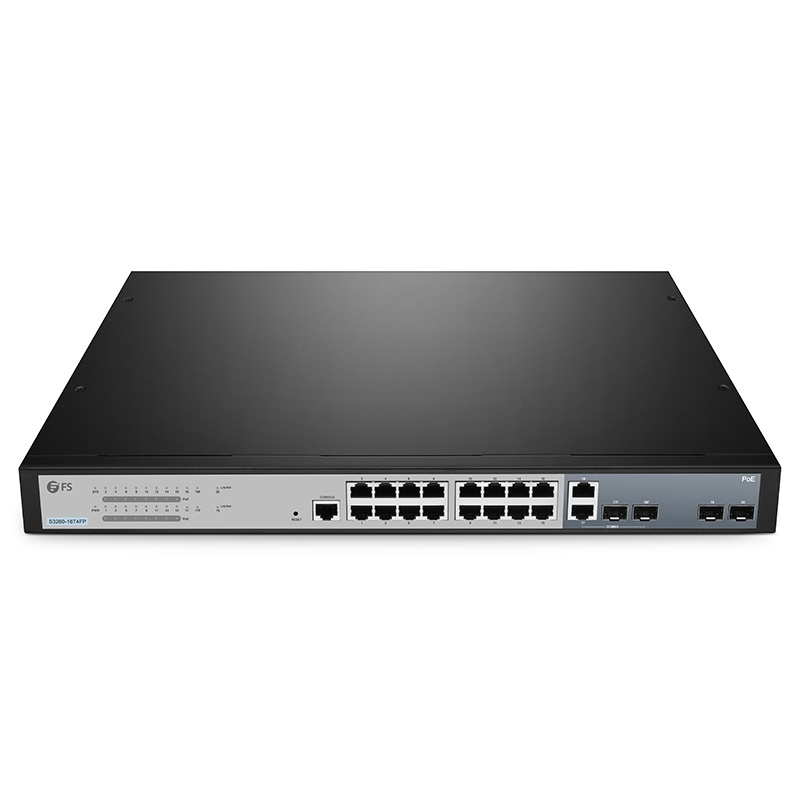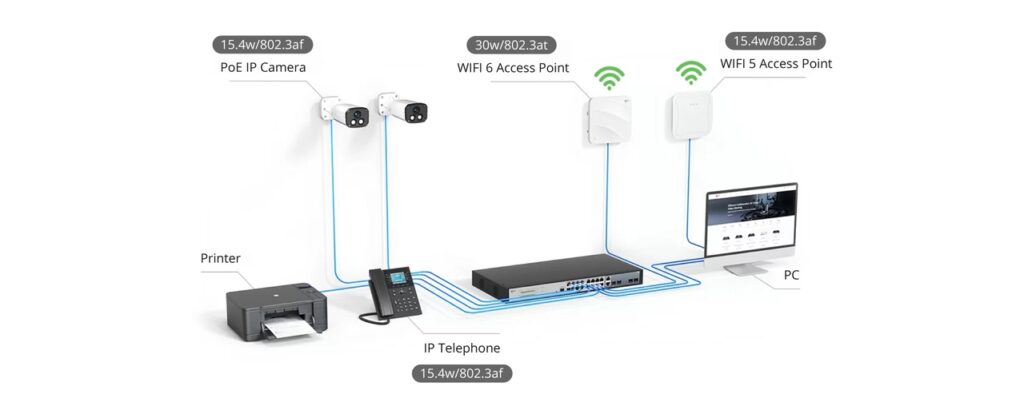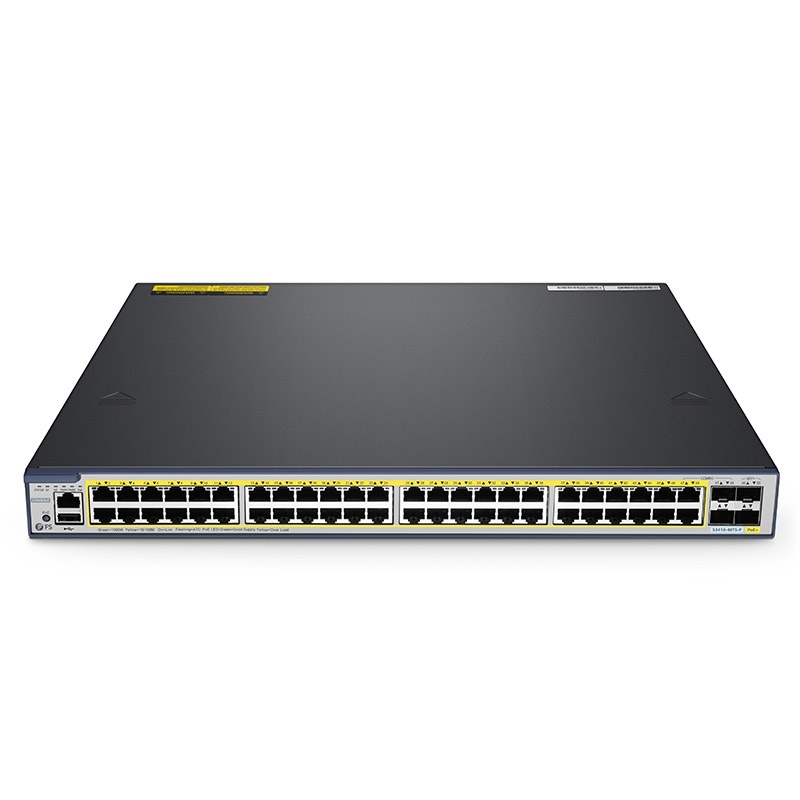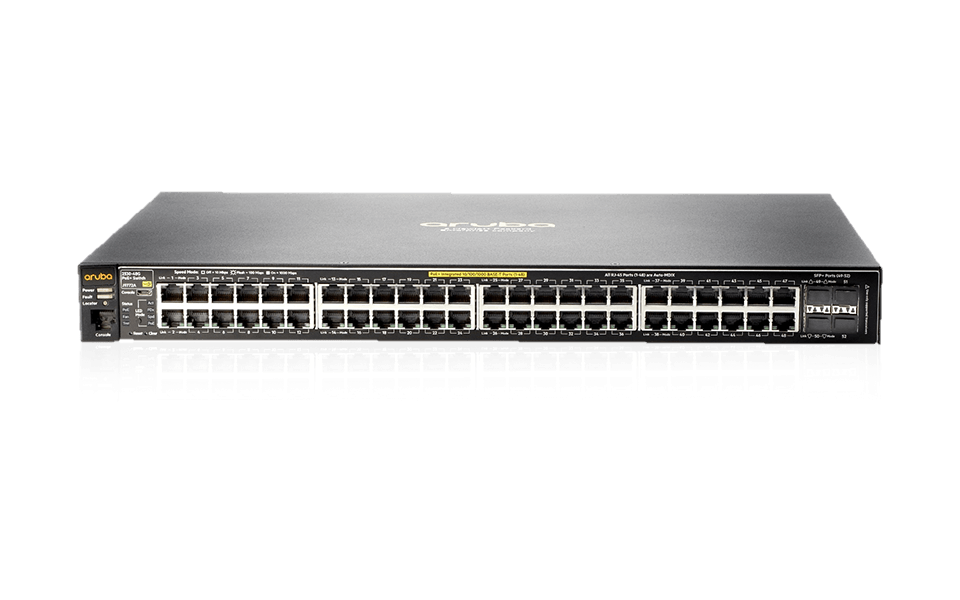For enterprises, the close integration of PoE Gigabit switches and cloud management platform brings new business advantages. This powerful synergy not only injects advanced technology into enterprise network architecture but also takes an important step towards improving efficiency, flexibility, and overall control. This article will explore the integration of PoE Gigabit switches and cloud management platforms. It will highlight how they collaborate to establish an intelligent and efficient network management environment for enterprises, promoting sustainable business development.
The Features of PoE Gigabit Switches
PoE Gigabit switches provide data and power to devices over Ethernet cables, require less wiring, and are easy to install. In addition, PoE Gigabit switches have many advantages:
Transmission Rate
As network technology continues to advance, the evolution of POE switch speeds has undergone several stages. In its early days, POE switches supported speeds of 10/100Mbps. These switches could deliver a maximum data transfer rate of 100Mbps while providing power to connected devices. With the growing demand for higher network speeds, PoE Gigabit switches came into play. These switches support Gigabit Ethernet speeds, offering increased bandwidth suitable for scenarios requiring faster data transfer. Taking the FS S3150-8T2FP as an example, the ports have a maximum power of 30W, and the POE total power budget is 130W.
Application Scenarios
A 1G PoE switch is commonly employed in small to medium-sized enterprises and office spaces, facilitating efficient data transmission for network devices while concurrently supporting power supply. This type of switch is well-suited for scenarios involving the connection of devices such as IP cameras, wireless access points, and IP phones, streamlining the deployment of wiring. The PoE functionality it offers enables the provision of power to various devices, reducing the need for power outlets. This feature proves particularly advantageous in environments that demand flexible layouts and space conservation, such as surveillance systems, office buildings, and small enterprise networks.
PoE Power Supply
The 1G PoE switch adopts the IEEE 802.3af and IEEE 802.3at standards, delivering power outputs of 15.4 watts and 30 watts, respectively. These high-power standards are applicable in scenarios requiring long-distance power supply and high-power devices, such as surveillance cameras, wireless access points, and IP phones.
Overall Design
The design of a 1G PoE switch typically falls into three categories: wall-mounted, rack-mounted, and desktop. The wall-mounted design is suitable for environments with limited space, allowing for flexible placement on the wall. The rack-mounted option is well-suited for data rooms, facilitating neat and organized installation within a rack. The desktop design, on the other hand, is applicable to flat surfaces like office desks, providing convenience in arrangement and management. These designs not only take into account the practical needs of various application scenarios but also prioritize aesthetic appeal and user-friendliness, offering users a diverse range of choices.
What is a Cloud Management Platform?
Cloud management platform allows you to run your business network remotely from resources in the cloud without having to manage your business network on-site with a network controller or management software. cloud management platform has the following advantages:
- Remote Operations. With cloud management platform, you can operate your business network remotely without the need for on-site controllers or direct management software.
- Cost Reduction. The cloud management platform is integrated into business workflows to provide accurate reporting and reduce management costs while maintaining cloud environments.
- Centralized Management. Utilizing the central management platform provided by cloud service providers, you can efficiently manage multiple sites, users, and devices.
- Swift Deployment and Operations. Cloud management platform support rapid remote delivery and operations, shortening the network deployment cycle.
- Enhanced Network Adaptability. Cloud management platform empower businesses with greater adaptability, allowing them to address network management challenges across different locations and requirements easily.

Why Choose Integration Management Solution for PoE Gigabit Switches?
Simplify Deployment and Configuration
The integration of PoE Gigabit switches with a cloud management platform simplifies the deployment and management of switches. Through this integration, remote configuration and monitoring become conveniently accessible, enhancing the network’s flexibility and adaptability. For hosted PoE Gigabit switches, you can also access them via the Internet or local networks. This access includes the capability to remotely restart edge devices that may encounter issues. In the prevalent remote work scenarios, the synergy between PoE Gigabit switches and cloud management ensures a stable and dependable network.
Real-time Monitoring and Troubleshooting
Traditional PoE network management involves manual configuration and monitoring, which becomes cumbersome with business growth. However, as the majority of enterprises adopt PoE Gigabit Switches as their primary hardware devices, with uplink ports supporting various speeds and downlink ports providing a basic 1G speed to meet the daily requirements of terminal devices, the advantages of integrated PoE management become evident. This integrated management approach not only simplifies maintenance processes but also enables more precise identification and resolution of network issues, providing enterprises with a more convenient and efficient PoE network management experience.
Enhancing Efficiency and Cost Savings
When using PoE Gigabit switches, leveraging a cloud management platform for the unified management and control of network devices brings significant advantages. Compared to the intricate, time-consuming maintenance required in traditional network management, cloud management eliminates the need for lengthy operations, thereby reducing long-term operational costs. Additionally, FS PoE Gigabit switches employ SFlow technology for advanced network monitoring, automatically detecting and providing the necessary power for PoE devices. This not only streamlines operational processes but also enhances the cost-effectiveness of overall network management.

Get Started with FS PoE Gigabit Switch and Airware Cloud
As businesses expand, the increasing number of terminal devices leads to the complexity of cables. Not using PoE switches to build a smart office network can significantly impact business efficiency. Traditional maintenance and management methods cannot precisely pinpoint network issues, and the deployment process is lengthy. Hence, an integrated management platform becomes crucial.
FS has recently introduced Airware cloud management platform that supports remote management and monitoring of PoE switches and terminal devices. Choosing a PoE Gigabit switch for building a smart network system and utilizing the Airware cloud platform enables unified management of branch office networks, enhancing your enterprise efficiency. The campus PoE switch, such as the S3410-48TS-P, offers 48 PoE ports for connecting terminal devices like IP phones, security cameras, video conferencing equipment, etc. Additionally, the switch supports protocols such as SSH, QoS, and ERPS, providing performance and security assurance, making it a cost-effective choice.
FS currently provides various solutions for campus, home, SMB, data center, industry, etc. All these can achieve integrated management through the cloud platform, delivering more value and innovation to your enterprise.
Related Articles:
FS Switches Now Support PicOS® for Unified Networking Experience











